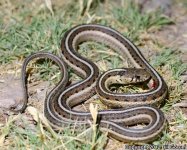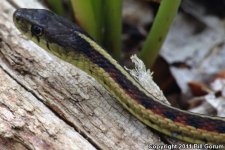| Range: |
 |
| Other Names: |
Garden Snake, Gardener Snake, Grass Snake |
| Subspecies: |
New Mexico Garter Snake Thamnophis sirtalis dorsalis |
| Description: |
Dorsal and side stripes usually well-defined. Dorsal stripe tan,
yellow orange or white. Body brown, light brown to olive. Frequently
red spots or blotches and a double row of alternating black spots on
the sides between the stripes. Belly bluish gray or greenish gray.
Scales keeled |
| Similar Species: |
Patchnoses and whipsnakes have smooth scales, a divided anal plate and no spots. The Blackneck, Mexican and Checkered garters all have dark neck blotches. The Plains Garter has the lateral stripe on rows 3 and 4. The Terrestrial Garter usually has 8 upper labials, never any red between scales and the paravertebral spots are distinct and not fused longutudinally. |
| Venom: |
Garters were long thought to be nonvenomous, but recent discoveries have revealed that they do in fact produce a mild neurotoxic venom. Garter snakes cannot kill humans with the small amounts of venom they produce, which is comparatively mild, and they also lack an effective means of delivering it. They do have enlarged teeth in the back of their mouth, but their gums are significantly larger. The Duvernoy's gland of garters are posterior (to the rear) of the snake's eyes. The mild venom is spread into wounds through a chewing action. - Wikipedia |
| Habitat: |
Found in many environments-grassland, woodland, scrub, chaparral and
forest. Lives in or near ponds, marshes, roadside ditches, streams,
woods, farms and city lots. |
| Behavior: |
Excellent swimmer. If stressed may bite and wipe released excrement on
its pursuer. Live bearing, and can have 3-85 young. |
| Hibernation: |
|
| Reproduction: |
Mate in the spring, live bearers |
| Diet: |
Eats amphibians, small mammals, lizards, earthworms and fish |
Authored by: Garth Teitjen
Sources:



|





















